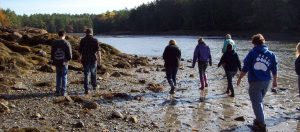Students’ Perspective on Collecting Data

Essential to scientific research is the ability to obtain meaningful and accurate data about the surrounding world.. The abilities to design and implement experiments and analyze data are absolutely necessary skills to succeed in the ever-advancing research sciences. During the SBS program, students fully engaged a variety of data collection and analysis methods. Two primary tools for research — field and laboratory work — are utilized almost every day of class. One of the greatest research skills is the ability to know your design’s limitations: this concept is stressed throughout the SBS program. Understanding the fundamentals of good experimental design and data collection helps SBS students push the to frontiers of exploration.
An Environment to Learn
At the Darling Marine Center (DMC), environments such as the rocky intertidal, mud flats, tidal estuary and the open Gulf of Maine are easily accessible. This setting allows SBS courses to have very strong field components. Many seemingly difficult concepts such as environmental gradients, ecosystem disturbance and human-environmental interactions transcend multiple classes. Having only one subject per day allows ample time to not only introduce a concept but also allow exploration in the natural realm. A typical class may include introduction to the topic and concept, followed by a field trip to collect data in the morning. In the afternoon or for homework, data will be analyzed and interpreted. One of the best aspects, from the perspective of many SBS students, are the daily field trips. A former SBS student states, “I have taken other ecology and experimental design based classes but never thought I would have as concrete a base as I do now, thanks to being immersed in the context of what I was learning.”
Specific Examples of Data Collection
All SBS classes have some type of field component. For example, “Marine Ecology” students explore the concepts that limit the distribution of organisms and provide biological gradients in the intertidal region (e.g., disruption, grazing, predation, heat stress, etc). Concepts build upon each other throughout the semester, leading into investigations of entire community structure and complex interactions. Each morning a topic is introduced and a research plan is discussed and reviewed. Afterward, the class relocates to a nearby field location that provides the best example of the concept in situ. In the field, data are gathered using the plan of action discussed earlier in class. Examples include using quadrats to assess predation and barnacle size distribution in the upper, mid and lower intertidal. Once back at the classroom, data from multiple groups are combined and organized using computer programs for interpretation through charts and graphs. This is just one example, however; data collection is a major component for just about every during SBS. Students collect faunal specimens and take part in many phytoplankton trawls during marine invertebrates and zooplankton courses respectively. The “IRA C” research vessel is a crucial tool allowing for daily research trips and providing ease of access to many marine environments.
